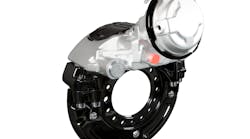The commercial vehicle industry is rapidly moving toward autonomous trucks. When it will get to the point where partially or fully autonomous vehicles dominate our nation’s highways is a topic of debate.
Many of the technologies needed for autonomous vehicles already are available. High automation (SAE Level 4), where the vehicle can perform all driving functions under certain conditions, has been demonstrated and is being tested on designated stretches of highways. In addition, autonomous technology like platooning also is being tested by a number of companies on the country’s 10 "proving grounds" for autonomous vehicle technology.
While many of the technologies for autonomous trucks are in place, the support infrastructure has yet to emerge. That is the critical element to large-scale autonomy which likely will take several years, possibly even decades, and major investment from the U.S., as well as individual states and municipalities to reach any significant scale.
Focus on safety first
In the meantime, advanced driver assistance systems (ADAS), including a suite of active safety technologies, are critical as the industry progresses toward autonomous vehicles. ADAS technologies are designed to help drivers keep trucks and buses in the proper lane, at the correct speed, while helping to prevent accidents like rollovers or collisions.
For example, some systems provide full braking even at highway speed to help avoid impending rear-end collisions. Others help prevent accidents by warning drivers of potential rear-end collisions and intervene if needed, or provide active steering to keep a vehicle in its lane.
When ADAS technologies are connected, they combine the active braking and steering capabilities needed for an autonomous vehicle. By providing longitudinal vehicle control (active braking) with lateral vehicle control (active steering), ADAS technologies lay the foundation for platooning and provide critical functions to enable autonomous driving in the global commercial vehicle industry.
What’s important now as the industry moves toward autonomy is that these technologies are making the roads safer and providing a much improved driving experience today.
IHS Markit conducted an analysis of crash avoidance technologies, including electronic stability control, forward collision warning, blind spot and lane departure. Findings from the study concluded “a combination of four crash avoidance features has the potential to prevent or mitigate more than one of every four large truck crashes, one of every three injury crashes and about one of five fatal crashes if every rig had them.”
Some ADAS technologies currently on the market can have an even more profound effect on accident reduction. Active braking safety systems, such as Wabco’s OnGuardACTIVE, help alert the driver to potentially critical driving situations and provides active braking on moving, stopping and stationary vehicles to mitigate or prevent impending rear-end collisions. Fleets using OnGuardACTIVE report up to an 87 percent reduction in rear-end collisions, and up to 95 percent reduction in rear-end accident costs.
In addition, the Federal Motor Carrier Safety Association (FMCSA) is promoting voluntary adoption of lane departure warning systems to trucking fleets to encourage safe driving behaviors and reduce crashes. According to a study by the FMCSA, the adoption of lane departure warning systems, such as Wabco’s OnLaneALERT, can help vehicles stay in their lane, keep drivers on the right track, help reduce crashes by 48 percent and provide economic benefit of $1.2 billion annually.
Advancements with brake technology
Whether looking at safety-related technologies today or looking ahead to autonomous vehicles, the foundation starts with braking; and more specifically, with air disc brakes (ADBs).
ADBs are increasing their share of the commercial vehicle market. Approximately 20 percent of commercial vehicles and 15 percent of trailers are currently equipped with ADBs. That is expected to increase to about 30 percent of trucks and 25 percent of trailers in the next couple years, and both will continue to grow share.
More truck manufacturers are offering ADBs as standard equipment. As ADBs on trucks increase, it’s important to use comparable brakes on the trailer to ensure compatibility and optimal effectiveness. The more fleets, drivers and workshops are exposed to ADBs, the more they appreciate them.
One reason for the increased adoption of ADBs is their benefits they offer over drum brakes. For drivers, ADBs provide superior reliability, shorter stopping distance and a feel that is more like that of a passenger car. ADBs have fewer parts than drum brakes. This means during service, technicians can provide faster maintenance and expanded service intervals. Plus, for fleets who are continually monitoring operational costs, the payback for ADBs averages less than two years.
While the commercial vehicle industry continues to move closer to autonomous trucks, the technologies that will help the industry get there are being used today to help keep commercial vehicle drivers safe. These technologies, which are critical to autonomy and advanced functionalities such as platooning, all start with superior reliability and stopping distance based on the better braking provided by ADBs.
The human element
While the industry may someday rely on fleets of driverless vehicles, the driver continues to play a critical role in the commercial vehicle industry and will for the foreseeable future. That makes industry adoption of ADAS technologies even more critical. The National Highway Traffic Safety Administration (NHTSA) says that 94 percent of crashes are tied to a human choice or error. With drivers in the cabs for years to come, suppliers will remain focused on innovating and further refining technologies that are not just the building blocks for autonomous vehicles, but also enhance driver effectiveness and safety.
Safer and easier-to-drive trucks also may help alleviate some of the driver-shortage problem. The American Trucking Association calculates that the industry will be short more than 63,000 drivers by the end of 2018. Increased safety may help keep some drivers in the market, and perhaps attract new drivers. Promoting the array of technologies in trucks may entice new candidates who are interested in a career field where they can utilize the leading-edge developments that are part of today’s vehicles.
Jon Morrison is president of the Americas for Wabco. Previously, he has also served as Vice President Vehicle Dynamics and Controls for the company, and as President and General Manager of Meritor Wabco, a previous joint venture between Meritor and Wabco. His 30-year career includes responsibilities in finance, manufacturing, sales and marketing and engineering as well as managing global customer relationships.


